Fig 3.
Neutrophil migration in the presence and absence of feed-back. (A) The Effective Displacement of the cell was tracked over the time in 10 experiments where feedback was applied and the stage was moved in equal and opposite distances of the cell’s movement. (B) The Effective Displacement of the cell was tracked over the time in 10 experiments where feedback was not applied and no stage movement occurred. (C) A trajectory of a cell that had low directional persistence (DP = 0.03). (D) A trajectory of a cell that had high directional persistence (DP = 0.66). (E) The average lifetime velocities of the tracked cells were calculated. No significant difference was found between the velocities of the cells that were kept in the same place relative to the gradient versus the cells that did not experience any stage feedback and moved up the gradient (p > 0.05). (F) The directional persistence of the cells was calculated by dividing the displacement of the cell in the direction of the gradient by the total displacement of the cell. The cells that experienced stage feedback and were kept in the same place relative to the gradient had significantly lower directional persistence than the cells that did not experience stage feedback and migrated up the gradient (p < 0.05).

